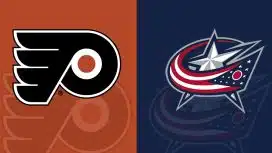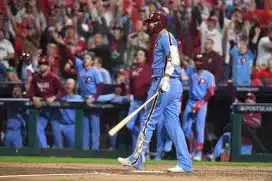Flyers
Flyers 5: Takeaways from Tuesday’s Flyers-Sabres Game
By Kevin Durso, Sports Talk Philly editor
It started off with the bang everyone expected. Less than two minutes into the game, the Flyers top line won a battle, created some space and an opportunity and finished. For the struggling Buffalo Sabres, who had lost seven straight games and were without their captain and best player, it seemed like the start of a long night.
But the Flyers struggles came into play for the rest of the period. Over the course of the next 18 minutes, three goals would find the net on eight shots. It forced Alain Vigneault to pull his goaltender and try to provide a spark. It worked.
While the Flyers were far from perfect for the remainder of the game, they out-played the Sabres from there and worked their way back into the game, finally tying it on a late power-play goal. It required a shootout, but they got the two points they needed to get against a team well below them in the standings.
That is what they can take away as a positive. They got the win, they got the two points, and offensively, they did a lot of good things that ultimately resulted in the number of goals they needed to get the game to overtime. But there are plenty of flaws that, at least this season, appear to be beyond repair, and that’s concerning with more tough matchups coming in the weeks ahead.
Here are five takeaways from Tuesday’s 5-4 shootout win.
1. Hart Problems
It’s almost like the beginning of Action News at 11 o’clock with Jim Gardner. Tuesday night, the Flyers get another win despite the defensive issues continuing, but the big story is…
In this case, it’s Carter Hart.
Let’s start with the performance itself. Hart’s 15th game of the 2020-21 season came in the 23rd game of the season for the team. It lasted one period.
The Flyers got the start they were looking for, getting a goal just 1:56 into the game. But the rest of the period was a disaster from just about every other angle. The defensive play was loose. There were plenty of turnovers. And Carter Hart was not bailing the Flyers out the way he usually does.
That’s where this problem begins. Two of the three goals Hart allowed in the first period could just as easily have nothing to do with him. The defensive coverage is weak and porous. It is easy to get into scoring areas and easy to get clean looks. That’s how poor the Flyers defensive coverages have been.
But there’s also an element of this to Hart’s game too. His angles can be a touch off, which for a goalie can be detrimental. He can look small in the net by playing too far back in the crease or going down too early. He can let up a rebound with no support when if he swallows up the chance, the play would be over.
The goalie is the last line of defense and often the difference between looking deeper into defensive breakdowns or letting them pass by. When the defense breaks down and the goalie makes a save, it may be a brief talking point, but it’s ultimately no harm, no foul. When a goal is scored, every angle of it is dissected.
Hart came out of the game on Tuesday night allowing three goals on eight shots to a team that averages the second-fewest goals in the NHL. The Sabres also entered the game with just 10 first-period goals, and had not scored more than one goal in the opening period of a game all season.
If Hart’s performance in the game, whether his own fault or the lack of defensive support, didn’t say enough, his appearance at the postgame press conference did. Hart’s had bad games before, even as recently as the playoff run the previous summer. He has always had an upbeat approach, vowing to learn and be better and usually following it up with a performance that makes you forget the struggles. This was a very different Carter Hart.
Hart was short with his answers. He was as despondent as ever. He looked lost and confused, wondering how he is supposed to fix what is going wrong.
Hart answered three questions in the press conference. He was asked where his confidence is at and if he realizes that he playing deeper in the crease than usual.
“I’m just trying to stop the puck and right now I’m not. Plain and simple,” Hart said. “I just need to find a way to get back on track because I’m not playing well. I know it. Everyone knows it. It’s hard right now. But the boys battled back and that’s all that matters.”
Hart was then asked if he was surprised Alain Vigneault pulled him after the first period.
“No. I didn’t play well. The boys needed a spark,” Hart said. “Moose came in and did a great job.”
Finally, Hart was asked about a comment that Vigneault had made in his presser, about needing to battle more and what that means for a goaltender.
“I don’t know. I just need to find more ways to stop pucks. Just go out and play. Not overthink things and just trust my game,” Hart said. “I don’t know, it’s just [expletive] right now. I don’t feel like myself and I have to find a way to get back to playing the game that I love and trusting the game that I’ve built.”
Hart sounds like he is at a complete loss. He sounds like his confidence is shot at the moment. He needs to be built back up. That might take more time than the Flyers have, especially in a shortened season with so many games on the horizon, tough ones at that.
For some additional context, Vigneault was asked about Hart twice during his availability. He was asked how concerned he was about Hart’s performance. Vigneault gave a response that stays the course with similar responses already this season.
“I replaced him because I didn’t think he had been good enough. I told Moose he was going in,” Vigneault said. “At the end of the day, it’s the toughest position in hockey. Carter is a very young goaltender. We all believe in him. We all think that he has a tremendous amount of potential. It’s a tough position.
“He’s going to learn from this. He’s going to get better. I believe he has to battle a little bit harder in goal at this time. I’m confident that he will work with Kim and he will try to get his game to where it needs to be so our team can have a chance in every game.”
Vigneault was later asked about how to balance a goalie’s usage when he goes through a rough stretch like Hart has been on. Vigneault responded by referring to two previous netminders he had.
“You’ve got to find a way to win games and a goaltender has to find a way to stop the puck. That being said, I’ve been very fortunate in this game to have some great goaltenders in front of me and in front of my teams. Lundqvist, Luongo, etc, etc. All those goaltenders at one time or another went through challenging periods,” Vigneault said. “All players do. Not just at the goaltender position. But all players do. You got to show mental strength, mental fortitude and you have to battle through. That’s what we expect Carter to do.”
In some ways, you can’t expect Vigneault to say anything other than what he did about his belief in Hart and the entire organization’s belief in Hart. But the significance of naming two goalie he coached that had similar paths to the top of the league shows just how difficult it is to not only find a goalie with that potential, but then get him to the level he can achieve.
In addition to Roberto Luongo and Henrik Lundqvist, Hart’s idol Carey Price went through a similar path as well. This isn’t about Hart’s ability not matching the potential. It’s not giving the potential a chance to be fully reached because the reality in the moment doesn’t meet the expectations.
There were odd-makers listing Hart as a Vezina Trophy dark horse this season. That frenzy carried over to parts of the fanbase who saw his rookie season, his sophomore season turned playoff appearance and the success there and assumed year three was going to be above and beyond their wildest imagination. In a way, it has been.
Hart had a 16-13-1 record with a 2.83 GAA and .917 save percentage in his first 31 games played as a rookie. Last season, he had a 24-13-3 record with a 2.42 GAA and .914 save percentage in 43 games played, then added a 9-5 record with a 2.23 GAA and .926 save percentage in 14 playoff games. This season, Hart is now 6-5-3 with a 3.61 GAA and .888 save percentage. He’s not just struggling. He’s getting flat-out lit up.
It’s a challenging time for the netminder for sure. It wouldn’t be a surprise to see a lot of Brian Elliott over the next week as Hart works on his game and gets a chance to stay off the ice against the opposition for right now. The Flyers play Washington on Thursday and Saturday, then hit the road for four games, starting Monday against the Rangers. There is a path to starting Elliott in the next three games before allowing Hart to step back in to face the Rangers next Wednesday as the Flyers start a back-to-back with another game on Thursday.
It’s clear Hart needs a break for now. How long that lasts will certainly be up to the coaching staff, but also up to Hart himself.
2. More Breakdowns
Hart didn’t exactly have help on any of the three goals he allowed in the first period.
Sam Reinhart scored his first of two goals in the period at 4:33. The play starts simply enough with a dump-in by a defenseman. Phil Myers actually is first to the puck at the other side of the ice after it wraps around the endboards. Myers looks like he tries to reverse it back behind the net, but doesn’t get all of it on the backhand, and that allows Taylor Hall to come in and take possession in a board battle.
As Hall takes control and gets the puck to Dylan Cozens, Reinhart comes off the wall from behind Joel Farabee and into open space. Reinhart gives it a quick release and it beats Hart, already going down before it is released, over the glove side high.
The second goal is another example of the Flyers not moving their feet and taking away a player in close to the net. The Flyers are trying to complete a line change as the play begins, but there is enough of a delay after Brandon Montour enters the zone to allow for bodies to get on the ice. Travis Sanheim actually makes a good play on the entry, poking the puck away from Montour, but Montour appears to hook him and take him down, allowing Victor Olofsson to get the puck and put it back down low.
Eric Staal swoops in behind Kevin Hayes to get to the loose puck, then cuts to the front of the net with Hayes closing in on him. The chance goes in on Hart, then pops back into the slot. Hayes has now exited the front of the net with Staal, but Riley Sheahan is there and waiting for the rebound in front. There are three Flyers nearby, but nobody ties up Sheahan and that allows him to send another backhander on goal and under Hart’s arm.
The third goal of the period, once again to Reinhart, is about losing track of coverage and leaving players unmarked.
Hall has control of the puck and speeds through the neutral zone, leaving Scott Laughton in the dust on a nice move. Hall continues to press forward and gets the angle on Justin Braun as he goes behind the net. Travis Konecny gets caught watching the puck, and doesn’t stay with Reinhart, who is now wide open in the slot. Reinhart again is able to unleash a shot that beats Hart high and makes it 3-1.
Even on the fourth goal, the Flyers get caught out of position as the puck makes its way across the zone to Montour. He is left unmarked for two or three seconds as he gets control and into shooting position. When he does released, Brian Elliott is square and ready, but the shot hits Shayne Gostisbehere’s stick and rises, going just off of Elliott’s shoulder and in.
3. Special Teams Keys Comeback
One of the bright spots that helped the Flyers get back into the game was special teams. Early on, it wasn’t such a bright spot, as the Flyers were quickly 0-for-2 on the power play again in this game.
On their third power play, they didn’t score, but did find the back of the net seconds after Buffalo was back to full strength.
In the third period on their fourth power play, with under seven minutes to play in regulation, the Flyers finally got the goal they needed. Gostisbehere fired a one-timer from the point that made it through multiple sticks and traffic to beat Jonas Johansson.
On the penalty kill, the Flyers also did their part. They only had to kill one penalty until the final 2:24 of the third, when Jake Voracek went to the box for tripping. The Flyers killed that one off too and got the game to overtime.
4. Making a Push
Another encouraging sign in this game was the response the Flyers had after falling behind early. On Saturday and again on Sunday, fatigue appeared to be a factor. That doesn’t mean it’s an excuse, but they looked tired and out of gas.
From the fourth Buffalo goal on, the Flyers were the better team. Even before Buffalo restored a two-goal lead in the second, the Flyers were generating a lot of possession time and winning more battles.
Obviously, the Flyers did not lack the energy needed to get back into the game and they had their legs. That certainly needs to carry over to future games.
5. Working It Out
So we’ve talked about Carter Hart. We’ve talked about the defensive breakdowns and the turnovers. We even touched on the inability to finish offensively in recent games. There is one common thread to all of this: these are issues that need to be worked on and worked out in the here and now.
The Flyers aren’t getting relief on the schedule and the opposition will only be tougher as the season goes on. If they want to be a playoff team, they need to get out of their own way. That means making saves, sticking with coverage and being a more sound defensive team, and managing the puck better.
It doesn’t come overnight, but it needs to come quickly for the Flyers. One player or one move isn’t going to change all of this. This is about a team buying in completely and doing what is needed to make the right play.
The two points the Flyers got on Tuesday was as ugly as it comes. In the standings, it looked beautiful. You know why? Because on the same night, three other teams in front of the Flyers in the division won their games. The only other team in front of them that didn’t win still got the game to a shootout and got a point. As it stands on Wednesday morning, the Flyers are one point out of a playoff spot, two points behind third (with two games in hand and three more head-to-head matchups), five points behind second (with two games in hand and six more head-to-head matchups), and seven points behind first (with three games in hand and six more head-to-head matchups).
It’s going to be a tough division and a tight division. That’s the challenge the Flyers face right now. They are still a growing team trying to contend in the here and now and doing it against four other formidable contenders in their own ways. All it takes is one hot streak, one stretch of hockey up to their full potential, and the standings could look a lot different.












































